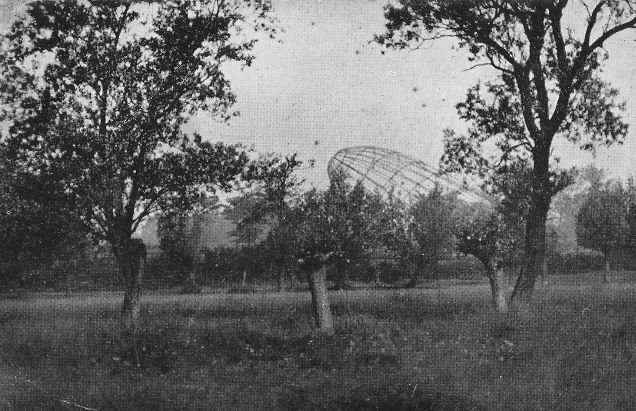ZEPPELINS, GOTHAS & 'GIANTS'
THE STORY OF BRITAIN'S FORGOTTEN BLITZ 1914-1918
16/17 June 1917
Bombed: Kent & Suffolk
Rather surprisingly, this raid set out for London on one of the shortest nights of the year with only about four hours of true darkness. Although six Zeppelins were earmarked for the raid, strong winds and engine problems meant only two crossed the English coast, L 42 and L 48.
Commanding L 42, Kapitänleutnant Martin Dietrich, cruised off the Kent coast before finally coming inland over the North Foreland lighthouse at 2.05am. Five minutes later a searchlight briefly found L 42 then lost her again. Dietrich headed south, keeping out to sea; he believed he was approaching Deal and Dover where he thought his bombs fell. In fact it was Ramsgate. Passing the town’s Marina Pier, L 42’s first bomb landed in the sea about 400 yards south-west of the pier, followed by another 150 yards further on which also fell in the sea, off the Royal Victoria Pavilion. The third bomb, however, made its mark. A 300kg HE bomb exploded on a building about 20 yards from the Clock Tower in Ramsgate Harbour, used at the time by the Royal Navy as an ammunition store. ‘A sheet of blood-red flame shot upwards and for hours ammunition of all kinds continued to explode with a tornado of fury.’ Such was the intensity of the explosions that some residents believed the Germans were attempting a landing.
The next bomb dropped in Albert Street, a narrow road near the harbour, where it demolished or seriously damaged a number of houses, with other damage extending over a wide area. At No. 45 the explosion killed 67-year-old Benjamin Thouless and injured his wife. Next door, at No. 47, Jonathan Hamlin and his wife also died, but his brother escaped with injuries. Two houses suffered when the next bomb detonated in a front garden in Crescent Road, amongst those injured was Lt. Warden of the Royal Flying Corps, home on leave. The following morning ‘it was impossible to walk in any of the main streets without feeling the crunch of glass under one’s feet’. The Borough Surveyor reported damage to 660 houses shops or other buildings.
The wreck of L 48 at Theberton
Having passed over the town, Dietrich headed away to the north-west, dropping four more bombs. One detonated about 100 yards from Southwood House, one in a field about 70 yards from where the railway crossed the Manston Road and two close together in a field about 50 yards from a railway cutting north-west of Nether Court Lodge. Continuing on the same heading L 42 neared the RNAS airfield at Manston but the five bombs dropped all fell in Poleash Fields near Manston village, about half a mile short of the airfield, breaking windows in seven houses. The final two bombs, both incendiaries, fell as L 42 turned to the north-east, landing harmlessly in fields at Lydden and at Nash Court as she approached Garlinge. L 42 only remained overland for 14 minutes. On her homeward journey L 42 evaded attacks by three RNAS aircraft from Yarmouth.
The other Zeppelin to reach England, L 48 commanded by Kapitänleutnant der Reserve Franz Georg Eichler, had the commander of the Naval Airship Division, Korvettenkapitän Viktor Schütze, on board. L 48 spent over well over two hours off the Suffolk coast before coming inland at about 2.00am south of Orfordness, having struggled with engine problems and a frozen compass. Too late to attack London, Eichler selected Harwich as a secondary target. After following an erratic path L 48 finally seemed on course but at 2.45am seven guns of the Harwich defences opened fire on her, eventually firing off over 500 rounds. In response L 48 dropped about nine bombs near Falkenham, which fell between Falkenham Wood and Lower Farm. Turning west, Eichler dropped another 13 bombs near Kirton, falling in fields roughly between Corporation Farm and St. Mary’s Church. Heading back northwards, L 48 dropped three bombs between Waldringfield and Martlesham, on farmland between Cross Farm Cottages and Cross Farm.
Still experiencing engine problems as he headed north, flying between 14,000 and 15,000 feet, Eichler received a radio message advising him of a helpful tail wind at 11,000 feet. Alerted to news of a Zeppelin approaching the Suffolk coast, two aircraft took off from the RFC’s Orfordness Experimental Station shortly before 2.00am. Both pilots pursued L 48 and Lt. E.W. Clarke in a BE2c fired four drums at long range as he was unable to get above 11,000 feet. Lt. F.D. Holder, flying a FE2b with Sgt. S. Ashby as his observer/gunner, made a number of attacks, but Holder’s front gun jammed and so did Ashby’s while firing his fifth drum. No.37 Squadron had also sent pilots up and shortly before 3.00am another aircraft went up from Orfordness, a DH2 flown by Capt. R. Saundby. With the sky beginning to lighten and L 48 still struggling overland, Saundby closed in and fired off three drums of ammunition at gradually shortening distances and Lt. L.P. Watkins flying a 37 Squadron BE12 from Goldhanger was also on his third drum when L 48 caught fire and began to burn. She crashed on fields at Holly Tree Farm at Theberton, Suffolk. Incredibly, three of the crew survived the crash and burning wreckage, but neither Eichler nor Schütze was among them.
Although Holder/Ashby, Saundby and Watkins all believed they had been responsible for the fatal shots and a shared victory seemed the obvious decision, the War Office awarded the honour of shooting down L 48 to Watkins.
Casualties: 3 killed, 16 injured
Damage: £28,159
Follow Us
© Ian Castle 2021
